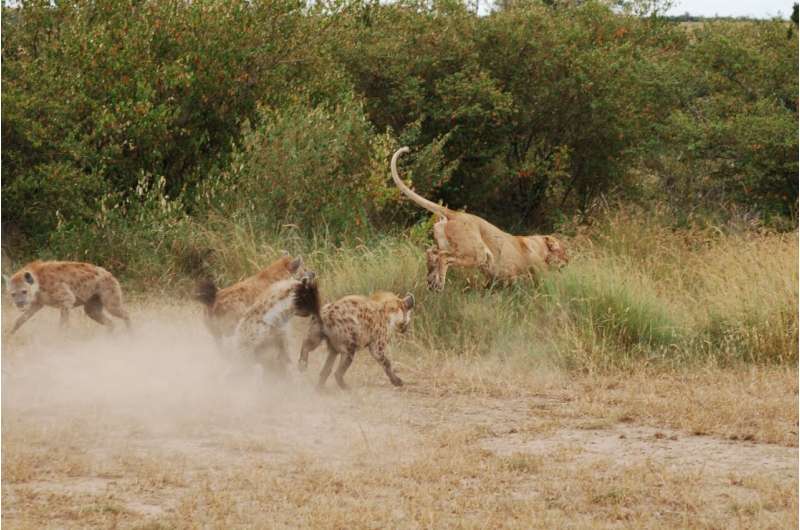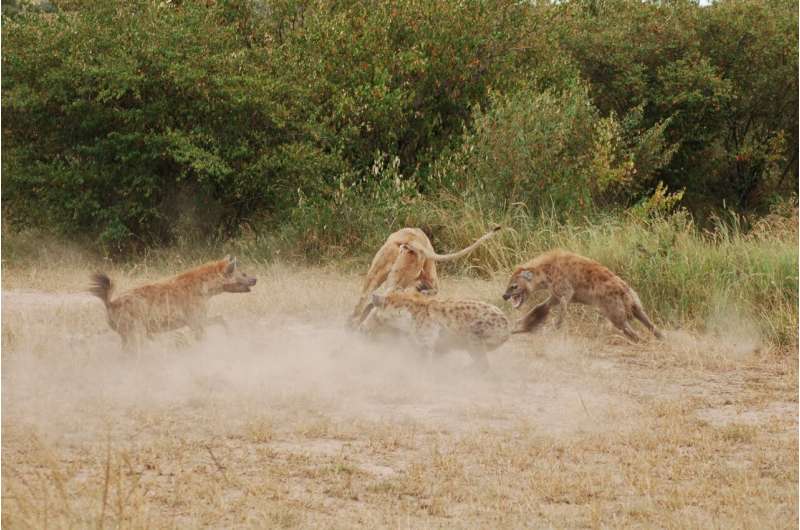Three spotted hyenas surround a lioness. Credit: Brittany Gunther, available under CC BY 4.0 DEED license.
After more than 35 years of surveillance, researchers at Michigan State University are revealing some of the secret workings of crowds. To be clear, these crowds are made up of spotted hyenas.
Publication in the journal Proceedings of the Royal Society B, the MSU team revealed that relationships and social interactions between hyenas can influence when two or more animals decide to work together to attack lions. This type of cooperative behavior is called mobbing.
“Social relationships can overcome barriers to harassment and allow hyenas to cooperate,” said Tracy Montgomery, one of the lead authors of the new report.
Montgomery started the project while she was earning her doctorate in Kay Holekamp’s lab at MSU.
“If hyenas greet each other, they are more likely to gather together,” said Montgomery, who is now a postdoctoral researcher at the Max Planck Institute of Animal Behavior and the University of Konstanz in Germany. “If they have strong social ties, they are more likely to engage in crowds.”
Spotted hyenas are social creatures with complex social structures that resemble baboons and other primates. Researchers study animals like these to explore how cooperative behaviors, like teaming up against a common enemy, evolved not only in wildlife but also in humans.
“It’s fascinating because it seems like something humans would do,” said Kenna Lehmann, another lead author who also worked on the project while earning her doctorate on Holekamp’s team. She is now an assistant professor at MSU.
“The relationships they build over time make the difference,” Lehmann said. “It’s not just, ‘I’ll give you a zebra leg if you help me’.”
“One of the most interesting aspects of this paper is the finding that hyenas are sensitive to social relationships across a range of temporal scales,” added Holekamp, professor emeritus of integrative biology in the College of Natural Sciences. from MSU.
“They base their decisions about whether or not to cooperate in harassing lions on short-term friendly behaviors and long-term friendly relationships.”

Four spotted hyenas watch a lioness walk away from them in the tall grass. Credit: Bretagne Gunther
“So weird and fascinating”
Holekamp has been studying hyenas in Kenya for 35 years, but it wasn’t his original project.
“I went to Kenya in 1988 thinking I would do a thesis project (three or four years) on hyenas, and then I would study dolphins, monkeys or other animals,” said Holekamp, who is also a core faculty member in MSU’s Ecology, Evolution and Behavior, or EEB, program.
“But the hyenas turned out to be so strange and fascinating that they captured my full attention.”
Consider, as a strange and fascinating example, the fact that female spotted hyenas have what are called pseudo-penis. Understanding why female genitalia are so similar to male genitalia is one of the big looming biological questions about hyenas, Holekamp said.
Although this question is not directly addressed in this study, it highlights why Holekamp finds hyenas so interesting.
“Spotted hyenas appear to violate many of the fundamental rules of mammalian biology,” Holekamp said. “By studying them, we can potentially determine what the rules actually are.”
As doctoral students working with Holekamp, Montgomery and Lehmann both became interested in hyenas’ rules of engagement when it came to harassing lions.
“We wanted to understand why they would take risks in this way – because it’s risky – and what they would get out of it,” Montgomery said.
When researchers are able to determine the cause of a hyena’s death, it is a lion in more than 25% of cases.
Lions and hyenas, however, have overlapping territories. So Lehmann and Montgomery first looked at mobbing through the lens of its obvious benefits, like fighting lions for food.
In a 2017 report published in Current zoologythe team showed that although harassment most often occurred near freshly killed food, hyenas also formed crowds when there was no obvious advantage.
“There were times when we were watching them thinking, ‘Why are you doing this? This is a very bad idea,” Lehmann said.

Three spotted hyenas try to surround a lioness who flees towards the tall grass, raising a cloud of dust. Credit: Bretagne Gunther
30 years of preparation
In their new study, the researchers delved deeper into bullying behavior to examine other motivations. In doing so, they also discovered that mobbing was more common when the risk of hyena injury or death was low, even in the absence of benefit.
For example, male lions are larger than females and more dangerous to hyenas. Hyenas were more likely to congregate when there were no male lions around. Conversely, in spotted hyenas, females are larger than males and females are more likely to join crowds.
But it is the social components of harassment that have attracted the most attention from researchers, and it is a discovery made possible by the observation of several generations of hyenas in the same habitat over 35 years. During this period, the team still had several collaborators present at its research camp in the Masai Mara National Reserve.
“We could never have done this study without it being part of a 35-year project,” Lehmann said.
One of the main reasons is that researchers don’t see crowds every day, far from it. The team has observed around 1,000 interactions between hyenas and lions over the past three decades.
Even rarer are the interactions where researchers can record all the information they need.
“These interactions are extremely rapid; there are often many hyenas and lions present, and most move quite quickly,” Holekamp said. “This makes it very difficult to record accurately and in enough detail what is happening to include it in our analyses.”
Of those approximately 1,000 interactions, 325 had data strong enough for Montgomery and Lehmann to analyze and make their findings. Both men acknowledged the hard work of students, research assistants and other collaborators over the past 30 years, who helped standardize and organize field observations into usable data sets.
And Holekamp’s team is still working to discover what other secrets these datasets hold.
“Finding these results was really exciting, but I feel like the fun part of science is you answer one question and immediately you have 50 more,” Montgomery said. “There are so many other things we need to do with this data.”
More information:
Tracy M. Montgomery et al, Determinants of hyena participation in risky collective action, Proceedings of the Royal Society B: Biological Sciences (2023). DOI: 10.1098/rspb.2023.1390
Provided by Michigan State University
Quote: ‘Friendly’ hyenas more likely to form crowds, research finds (December 5, 2023) retrieved December 6, 2023 from
This document is subject to copyright. Apart from fair use for private study or research purposes, no part may be reproduced without written permission. The content is provided for information only.



